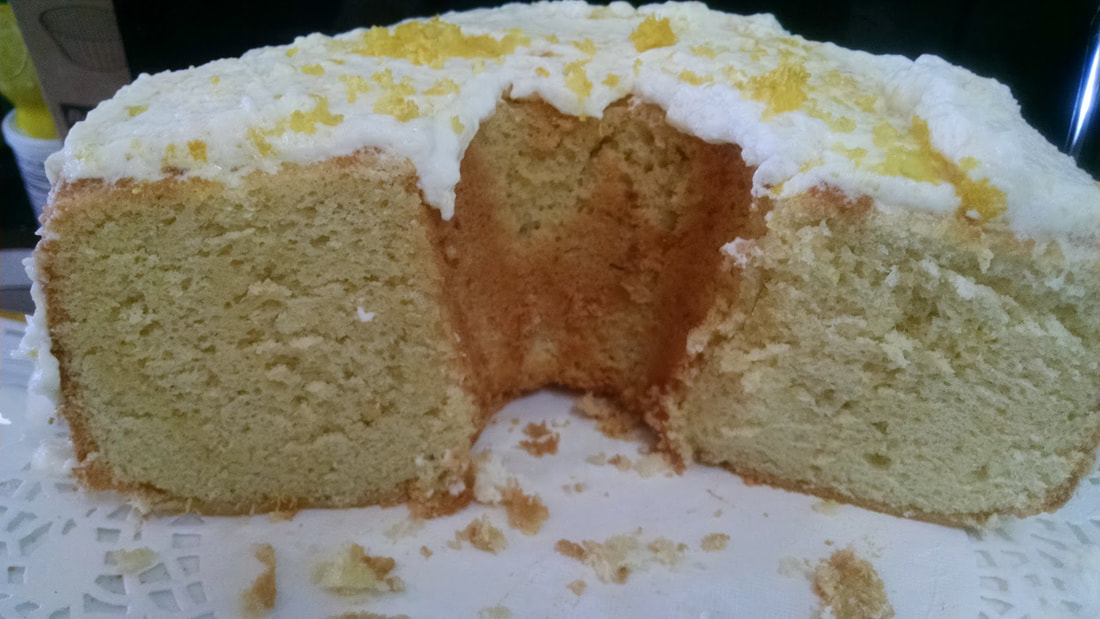|
This is the delightful cake I baked on an ABC-KVEW (Tri-Cities/Yakima) Good Morning Northwest appearance. Chiffon Cake is moist, light and airy; similar to an angel food cake but because it contains egg yolks and oil it will be much richer. Chiffon cake isn't difficult to make, however, you will need to pay attention to detail, following instructions carefully. I've modified the flavoring in the standard recipe slightly to create a citrusy gem that's flavorful yet subtle, perfect to bake on an early spring day. Grab your favorite Sous Chef, utensils and ingredients and get baking. LEMON CHIFFON CAKE (DAIRY FREE) · 2 cups Unbleached All-Purpose Flour (I prefer King Arthur) · 2 teaspoons baking powder · 1 1/2 cups sugar · 1/2 teaspoon salt · 1/2 cup vegetable or canola oil · 1 cup water · 8 large eggs, separated · 1 teaspoons vanilla extract · 2 teaspoons grated fresh lemon peel · 1 1/2 teaspoons lemon extract · 1/4- 1/2 teaspoon Fiori di Sicila · 1/2 teaspoons cream of tartar or lemon juice Step 1: Separate eggs Separate the egg whites from the yolks. Eggs separate more easily when cold, so separate them immediately after taking them out of the refrigerator. Even the tiniest bit of yolk can inhibit the beating quality of the whites. If any yolk gets into the white, do not use it; refrigerate that white for another use. To ensure that no yolk gets into the whites as you separate the eggs, separate each white into a small bowl, then transfer the white to the extra-large bowl in which you will eventually beat them. Place the yolks in a small mixing bowl. Allow the egg whites to stand at room temperature for 30 minutes (for food safety, do not let eggs stand longer than 30 minutes at room temperature). The standing time ensures that the whites will reach their full volume when you beat them. Step 2: Preheat oven Allow your oven to preheat at least 10 minutes or until the desired temperature has been reached. Use an oven thermometer to make sure it's at the proper temperature. Step 3: Combine dry ingredients Sift together the dry ingredients - flour, sugar, baking powder and salt. Make a well in the center of this mixture. To make a well, use a spatula or wooden spoon to gently push the dry ingredients against the side of the bowl. Step 4: Beat in wet ingredients Add the oil, egg yolks and other liquid to the well of dry ingredients, making sure to add these ingredients in the order specified in the recipe. Adding the oil first helps prevent the eggs from binding with the flour, which can cause streaks in the finished cake. Use an electric mixer to beat the mixture until satiny smooth. Tip: Measure Carefully Step 5: Beat egg whites Thoroughly wash and dry the beaters. In a separate bowl, beat the egg whites and cream of tartar on medium to medium-high speed until stiff peaks form. At this stage, the tips of the egg whites will stand straight when the beaters are lifted. Tips for beating egg whites: -- Make sure your beaters and mixing bowl are clean and dry. A speck of oil or egg yolk on either one can minimize the volume of the beaten egg whites. -- Avoid plastic bowls - even clean ones may hold oily residue that can affect the beating quality of the egg whites. -- Use a bowl that's wide enough to keep the beaters from being buried in the egg whites. -- Add cream of tartar or lemon juice to stabilize the egg whites. (Recipe can be made without cream of tartar or lemon juice but the cake will not rise as well.) -- Do not overbeat or underbeat egg whites -- your cake may fall. Egg whites should be stiff but not dry. Step 6: Fold ingredients Pour the egg-yolk batter in a thin stream over the beaten egg whites. Gently fold the batter into the egg whites. Use a spatula to cut down vertically through the mixture. Move the spatula across the bottom of the bowl; bring it back up the other side, carrying some of the mixture from the bottom over the surface. Repeat this process, rotating the bowl, until the ingredients are combined. Note: Be careful not to overmix at this stage. Overmixing can decrease the volume of the batter, resulting in a tough cake. Step 7: Pour batter into tube pan and bake Pour or spoon the batter into an ungreased 10-inch tube pan and bake as directed. Your cake is done when the top of it springs back when lightly touched. Step 8: Cool and remove cake from pan
Immediately invert the cake on a funnel or the neck of a bottle and cool it upside down to help set the cake's structure. Cooling upside down will prevent the weight of the cake from falling in upon itself. After the cake has cooled thoroughly (about 2 hours), loosen the sides of the cake from the pan and remove it. Step 9: Frost cake After the cake has cooled , frost it as desired. Lemon Glaze (Dairy Free) 1 1/2 cups sifted powdered sugar 2 Tablespoons fresh Lemon juice (or to desired consistency) 1/8 teaspoon Fiori Di Sicili Lemon Butter Cream Glaze 1/3 cup melted butter 1 1/2 cups sifted powdered sugar 2-3 Tablespoons fresh lemon juice 1/8 teaspoon Fiori di Sicilia Garnish with grated lemon peel, slice & enjoy!
0 Comments
|
ArchivesCategories |




 RSS Feed
RSS Feed
